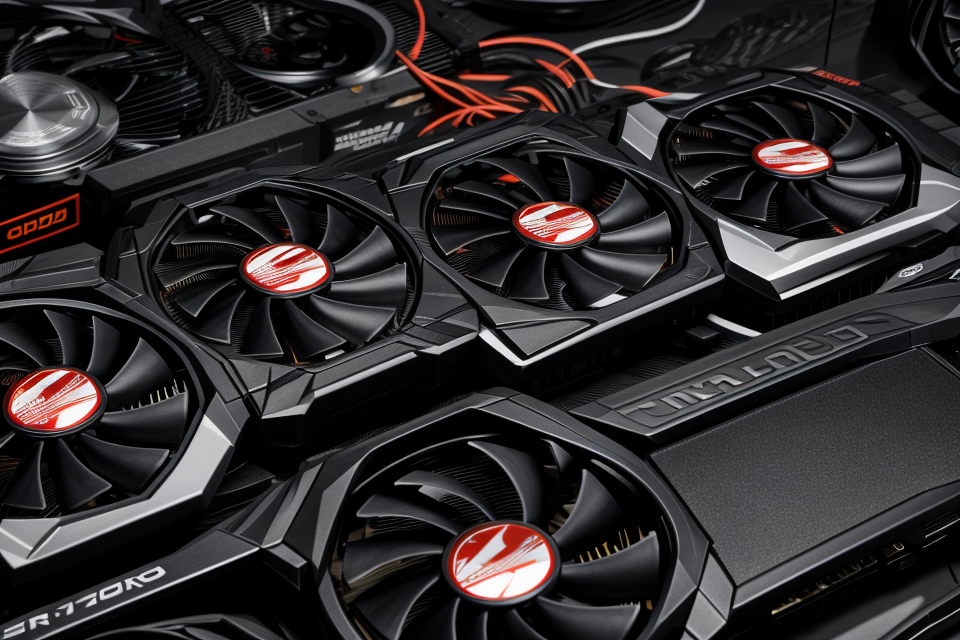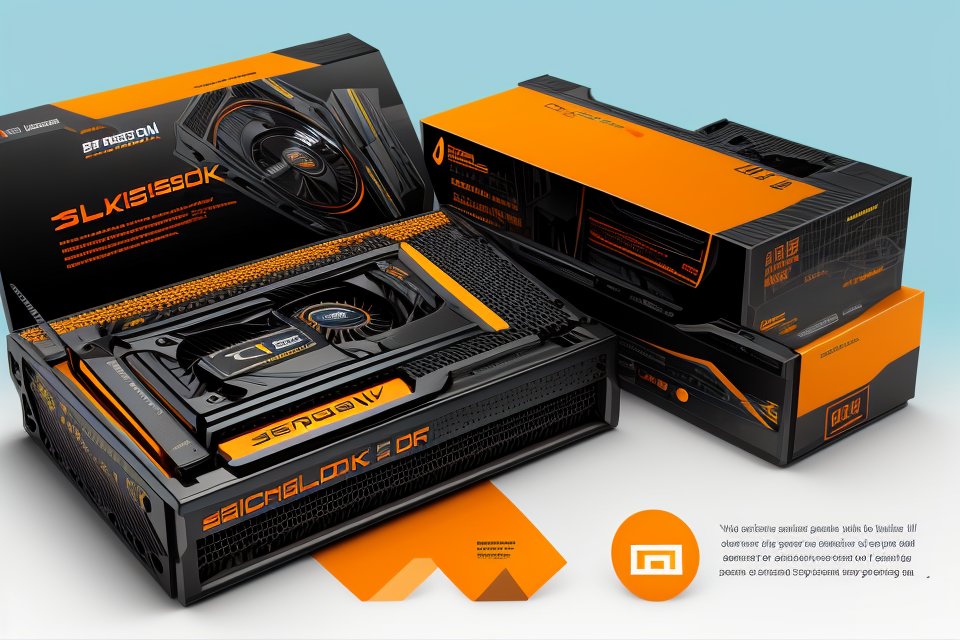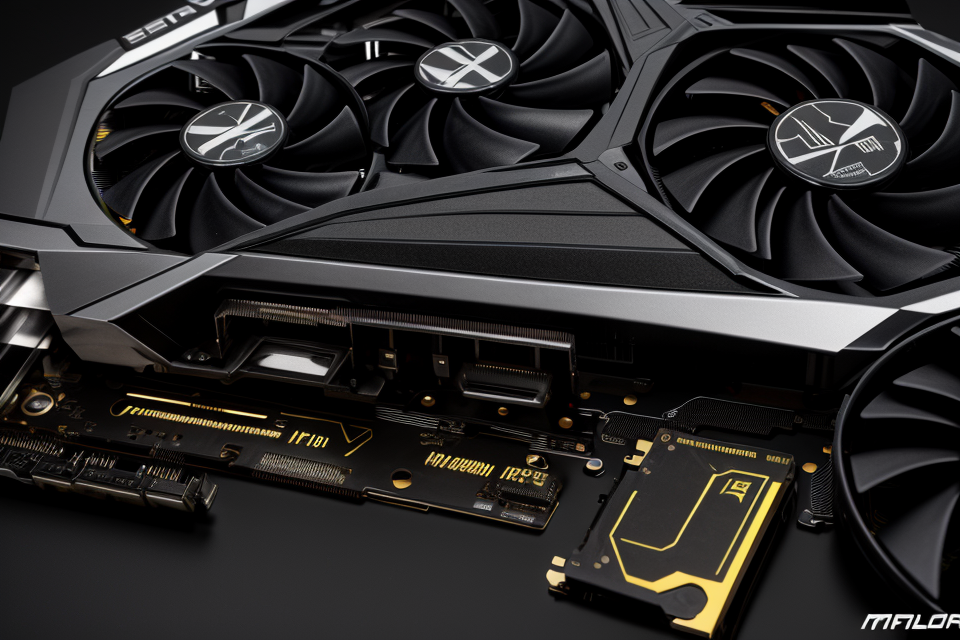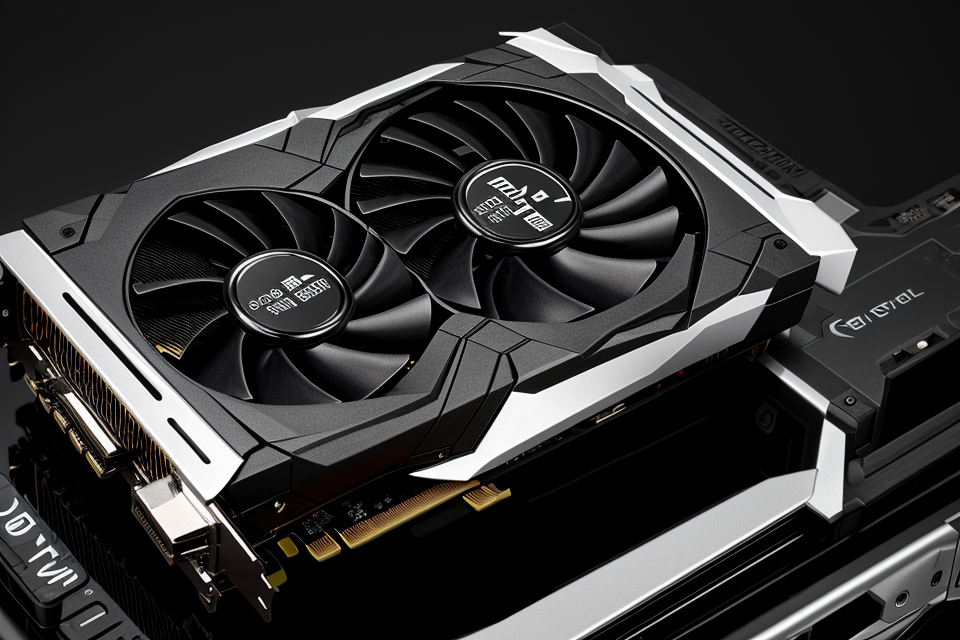
When it comes to gaming and graphic design, the graphics card is the most important component of your computer. It is responsible for rendering images and animations, and it can make or break your gaming experience. With so many different graphics cards on the market, it can be overwhelming to choose the right one for your needs. In this article, we will explore the most important features to consider when choosing a graphics card, including its performance, memory, and compatibility with other components. By the end of this article, you will have a better understanding of what to look for when choosing a graphics card, and you will be able to make an informed decision that will enhance your gaming and graphic design experience.
When choosing a graphics card, there are several important features to consider. Firstly, the performance of the card is crucial, and this is determined by factors such as the number of CUDA cores, clock speed, and memory bandwidth. Secondly, the compatibility of the card with your system is important, and you should ensure that it is compatible with your motherboard and power supply. Thirdly, the price of the card is also an important consideration, and you should choose a card that fits within your budget. Finally, the size and design of the card may also be important factors to consider, especially if you have a small form factor PC or limited space in your case.
Factors Affecting Graphics Card Performance
Power Consumption
When selecting a graphics card, it is crucial to consider its power consumption. The power requirements of a graphics card are typically measured in watts, and they can vary greatly depending on the model and its intended use. It is important to understand the power requirements of a graphics card to ensure that the power supply unit (PSU) can handle the load.
One way to determine the power requirements of a graphics card is to look at its TDP (Thermal Design Power), which is the maximum amount of power the cooling system is designed to dissipate. However, it is important to note that TDP is just an estimate, and actual power consumption can vary depending on the workload and other factors.
Matching the power supply unit (PSU) with the graphics card is also essential. A PSU that is not powerful enough can cause instability, crashes, and even damage to the graphics card or other components. It is recommended to choose a PSU that has a higher wattage than the graphics card’s TDP to ensure stable operation.
Another factor to consider is the efficiency of the graphics card. Some graphics cards are more energy-efficient than others, which can help reduce power consumption and save on electricity costs. It is essential to compare the energy efficiency of different graphics cards before making a purchase.
In summary, power consumption is a critical factor to consider when choosing a graphics card. Understanding the power requirements of a graphics card and matching it with a suitable power supply unit can ensure stable operation and prevent damage to the components. Additionally, considering the energy efficiency of a graphics card can help reduce power consumption and save on electricity costs.
Cooling System
A graphics card’s cooling system plays a crucial role in its performance and lifespan. Poor cooling can lead to overheating, which can cause the card to crash or degrade over time. Conversely, an effective cooling system can prolong the card’s lifespan and maintain its performance over time.
There are several types of cooling systems available for graphics cards, each with its own pros and cons.
- Air Cooling: Air cooling is the most common type of cooling system used in graphics cards. It typically consists of a heatsink and fan that dissipate heat generated by the card. Air cooling is relatively simple and cost-effective, but it can be loud and may not be sufficient for high-performance cards.
- Liquid Cooling: Liquid cooling systems use a liquid coolant to transfer heat away from the card. These systems are more efficient than air cooling and can be quieter, but they are also more complex and expensive.
- All-in-One (AIO) Liquid Cooling: AIO liquid cooling systems are a popular alternative to traditional liquid cooling. They consist of a single unit that includes a radiator, pump, and liquid coolant. AIO cooling systems are easy to install and can be more affordable than custom liquid cooling, but they may not be as efficient as traditional liquid cooling.
- Hybrid Cooling: Hybrid cooling systems combine air and liquid cooling. They typically use an air cooler for the GPU and a liquid cooler for the VRM (voltage regulation module). This approach can provide the benefits of both air and liquid cooling, but it can also be more complex and expensive.
When choosing a graphics card, it’s important to consider the cooling system and how it fits your needs. If you’re building a high-performance gaming PC, you may want to consider liquid or hybrid cooling to ensure optimal performance and longevity. However, if you’re building a budget PC for basic tasks, air cooling may be sufficient and more cost-effective.
Memory Capacity and Type
When choosing a graphics card, one of the most important factors to consider is the memory capacity and type. The memory capacity of a graphics card refers to the amount of memory it has, which determines how much data it can store and process at any given time. The type of memory used in a graphics card also plays a crucial role in its performance.
The impact of memory capacity on graphics performance
The memory capacity of a graphics card is directly related to its performance. A graphics card with more memory can handle more complex graphics and processes, which makes it better suited for tasks such as gaming, video editing, and 3D modeling. In general, the more memory a graphics card has, the better its performance will be.
Understanding different types of memory, such as GDDR and DDR
There are several different types of memory used in graphics cards, including GDDR and DDR. GDDR (Graphics Double Data Rate) is a type of memory specifically designed for use in graphics cards. It is capable of transmitting data at high speeds, which makes it well-suited for graphics-intensive tasks.
DDR (Double Data Rate) is a type of memory used in a wide range of devices, including graphics cards. It is designed to transfer data on both the rising and falling edges of the clock signal, which allows it to transfer data at twice the rate of standard memory. This makes it a good choice for graphics cards that need to handle a lot of data quickly.
Overall, when choosing a graphics card, it is important to consider the memory capacity and type. A graphics card with more memory and a suitable type of memory will be better able to handle the demands of your graphics-intensive tasks.
Core Clock Speed and Number of Cores
When choosing a graphics card, one of the most important factors to consider is the core clock speed and number of cores. The core clock speed refers to the speed at which the GPU’s processor executes instructions, while the number of cores refers to the number of processing units within the GPU. Both of these factors play a crucial role in determining the performance of the graphics card.
How core clock speed and number of cores affect graphics performance
The core clock speed of a graphics card directly affects its performance. A higher core clock speed means that the GPU can process more instructions per second, resulting in faster graphics rendering and higher frame rates. This is particularly important in demanding games or applications that require a lot of graphical processing power.
Similarly, the number of cores on a graphics card also plays a significant role in its performance. More cores mean that the GPU can perform more calculations simultaneously, leading to faster graphics rendering and improved performance. However, it’s important to note that having more cores doesn’t always result in better performance, as the efficiency of the cores and the architecture of the GPU also play a crucial role in determining overall performance.
Understanding the differences between various core clock speeds and core counts
When comparing graphics cards, it’s important to understand the differences between various core clock speeds and core counts. A higher core clock speed and more cores generally translate to better performance, but it’s important to consider the specific use case and budget when making a decision. For example, a graphics card with a higher core clock speed and more cores may be more expensive, but it may also offer significant performance benefits in demanding applications.
In summary, the core clock speed and number of cores are important factors to consider when choosing a graphics card, as they directly affect the performance of the GPU. Understanding the differences between various core clock speeds and core counts can help you make an informed decision when choosing a graphics card that meets your specific needs and budget.
Price and Budget Considerations
When choosing a graphics card, it is important to consider the relationship between price and performance. This relationship can vary depending on the specific model and brand of the graphics card. Understanding this relationship can help you determine a budget and find the best value for your needs.
It is important to keep in mind that a higher price does not always mean better performance. In some cases, a more expensive graphics card may not offer significantly better performance than a less expensive one. Therefore, it is important to do your research and compare different models to find the one that best meets your needs and budget.
Additionally, it is important to consider the long-term costs of owning a graphics card. While a more expensive graphics card may have a higher upfront cost, it may also have a longer lifespan and be more reliable in the long run. On the other hand, a less expensive graphics card may need to be replaced more frequently, which can result in higher costs over time.
In conclusion, when considering the price and budget for a graphics card, it is important to consider the relationship between price and performance, do your research, and compare different models to find the one that best meets your needs and budget. Additionally, it is important to consider the long-term costs of owning a graphics card.
Additional Features to Consider
Compatibility with Motherboard and CPU
When choosing a graphics card, it is important to consider its compatibility with the motherboard and CPU. Ensuring proper compatibility between these components is crucial for optimal performance and to avoid any issues during installation. Here are some key points to keep in mind:
- Expansion Slots: Different graphics cards require different expansion slots on the motherboard. It is important to know the slot type and its purpose to ensure that the card will fit properly.
- PCIe (Peripheral Component Interconnect Express) Version: The PCIe version determines the data transfer rate and overall performance of the graphics card. It is important to choose a card that is compatible with the motherboard’s PCIe slots.
- Power Supply Unit (PSU): The graphics card requires a certain amount of power to operate. It is important to check the PSU’s wattage and make sure it is sufficient to power the card.
- Chipset Compatibility: Some graphics cards may not be compatible with certain chipsets on the motherboard. It is important to check the manufacturer’s website for compatibility information.
- Cooling System: Some graphics cards require a specific type of cooling system, such as a fan or liquid cooling. It is important to choose a card that is compatible with the motherboard’s cooling system.
Overall, it is important to do research and verify compatibility between the graphics card, motherboard, and CPU before making a purchase.
Display Ports and Connectors
When it comes to choosing a graphics card, display ports and connectors are essential features to consider. These ports and connectors determine the display output capabilities of the graphics card, which directly affects its performance and compatibility with other devices.
Here are some important aspects to consider when evaluating the display ports and connectors of a graphics card:
- Gaming performance: A graphics card with more display ports and connectors can provide better gaming performance. This is because it can support multiple displays, which can be used to display game content on multiple screens or to extend the game screen for a more immersive experience.
- Compatibility: It is important to consider the compatibility of the graphics card with other devices that you plan to connect to it. For example, if you plan to connect a high-resolution display to the graphics card, you should ensure that it supports the required resolution.
- Display technologies: Some graphics cards support specific display technologies, such as 4K, HDR, or G-Sync, which can enhance the visual quality of the display output. If you plan to use these technologies, you should ensure that the graphics card supports them.
- Port configuration: The configuration of the display ports and connectors can also affect the performance and compatibility of the graphics card. For example, having more ports can allow for more devices to be connected, while having a mix of different types of ports can affect the performance of certain devices.
In summary, when choosing a graphics card, it is important to consider the display ports and connectors to ensure that it meets your gaming and graphics-intensive application requirements. You should evaluate the gaming performance, compatibility, display technologies, and port configuration to make an informed decision.
Overclocking Capabilities
Overclocking is the process of increasing the clock speed of a graphics card beyond its default specifications. This can improve the card’s performance and enable it to handle more demanding tasks. However, it is important to note that overclocking can also increase the temperature of the card and may require additional cooling to prevent damage.
When considering a graphics card with overclocking capabilities, it is important to look for the following features:
- Unlocked BIOS: An unlocked BIOS allows for manual overclocking of the card, which can improve performance.
- High-quality cooling solution: A high-quality cooling solution, such as a custom-designed heatsink or water cooling system, is necessary to maintain safe temperatures when overclocking.
- Durable components: Overclocking can put additional stress on the card’s components, so it is important to choose a card with durable and high-quality components.
In conclusion, overclocking capabilities can improve the performance of a graphics card, but it is important to consider the additional cooling and durability requirements when choosing a card with this feature.
Brand Reputation and Customer Support
The Role of Brand Reputation in the Quality and Reliability of Graphics Cards
When choosing a graphics card, it’s important to consider the brand reputation of the manufacturer. Established brands with a history of producing high-quality products are more likely to provide a reliable and durable graphics card. A reputable brand is also more likely to provide regular updates and drivers to ensure optimal performance and compatibility with the latest software and games.
The Importance of Customer Support in Case of Issues or Troubleshooting
In addition to the quality of the product, customer support is a crucial factor to consider when choosing a graphics card. It’s important to choose a brand that offers responsive and knowledgeable customer support in case of any issues or troubleshooting needs. A good customer support team can help resolve issues quickly and efficiently, minimizing downtime and frustration.
Furthermore, some brands offer additional warranties or repair services that can provide peace of mind and protect your investment in the long run. When considering customer support, it’s important to research the brand’s reputation for providing timely and effective assistance, as well as the specific support options available for their graphics cards.
Future-Proofing
When choosing a graphics card, it’s important to consider not only your current needs but also your future requirements. With technology constantly evolving, you want to make sure that your graphics card will be able to keep up with the demands of new games, software, and hardware. Here are some key factors to consider when future-proofing your graphics card purchase:
- Compatibility with Next-Generation Technologies: Make sure your graphics card is compatible with the latest technologies such as VR, 4K resolution, and HDR. Check the manufacturer’s website for updates and ensure that your graphics card is capable of handling these features.
- Upgradability: Choose a graphics card that can be easily upgraded in the future. Look for models with upgradeable BIOS and good cooling systems to make it easier to add more power in the future.
- Power Efficiency: As technology advances, power efficiency becomes increasingly important. Look for graphics cards with energy-efficient designs and high efficiency ratings to ensure that your system stays power-efficient even as you upgrade in the future.
- Performance: Lastly, consider the performance of the graphics card. Choose a card that has a proven track record of delivering high performance, even in the face of new and demanding technologies. This will help ensure that your graphics card will continue to meet your needs as they evolve over time.
FAQs
1. What is a graphics card?
A graphics card, also known as a GPU (Graphics Processing Unit), is a component of a computer that is responsible for rendering images and videos. It is an essential part of a computer’s hardware that is used to handle graphical tasks such as gaming, video editing, and 3D modeling.
2. What are the important features of a graphics card?
The important features of a graphics card include its performance, memory, power consumption, compatibility, and cooling system. The performance of a graphics card is measured in terms of its clock speed, memory bandwidth, and number of cores. Memory refers to the amount of video memory that a graphics card has, which determines how much data it can store. Power consumption measures how much power a graphics card uses, which is important for those who want to build an energy-efficient computer. Compatibility is also important as it ensures that the graphics card will work with other components in the computer. Finally, a good cooling system is necessary to prevent the graphics card from overheating during heavy use.
3. What is clock speed?
Clock speed, also known as frequency, refers to the speed at which a graphics card’s processor (also known as the GPU) can perform calculations. It is measured in MHz (megahertz) and is an important factor in determining a graphics card’s performance. The higher the clock speed, the faster the graphics card can process data.
4. What is memory bandwidth?
Memory bandwidth refers to the amount of data that a graphics card can transfer from its memory to its processor per second. It is measured in MHz and is an important factor in determining a graphics card’s performance. The higher the memory bandwidth, the faster the graphics card can access and process data.
5. What is the number of cores?
The number of cores refers to the number of processing units that a graphics card has. It is an important factor in determining a graphics card’s performance as it affects how many calculations the graphics card can perform simultaneously. Most modern graphics cards have multiple cores, with the number of cores ranging from 4 to 8 or more.
6. What is video memory?
Video memory, also known as VRAM (Video Random Access Memory), is the amount of memory that a graphics card has dedicated to storing image and video data. It is an important factor in determining a graphics card’s performance as it affects how much data the graphics card can store and how quickly it can access that data. The more VRAM a graphics card has, the more data it can store and the smoother the image quality will be.
7. What is power consumption?
Power consumption refers to the amount of power that a graphics card uses. It is an important factor to consider when choosing a graphics card as it affects the overall energy consumption of the computer. Some graphics cards require more power than others, so it is important to choose a graphics card that is compatible with the power supply of the computer.
8. What is compatibility?
Compatibility refers to the ability of a graphics card to work with other components in a computer. It is an important factor to consider when choosing a graphics card as it ensures that the graphics card will work properly with the other components in the computer. Some graphics cards may not be compatible with certain motherboards or power supplies, so it is important to check the specifications before purchasing a graphics card.
9. What is a cooling system?
A cooling system is a component of a graphics card that is responsible for dissipating the heat generated by the graphics card during operation. It is an important factor to consider when choosing a graphics card as it ensures that the graphics card will not overheat during heavy use. Some graphics cards come with built-in cooling systems, while others may require an additional cooling solution such as a separate heatsink and fan.


